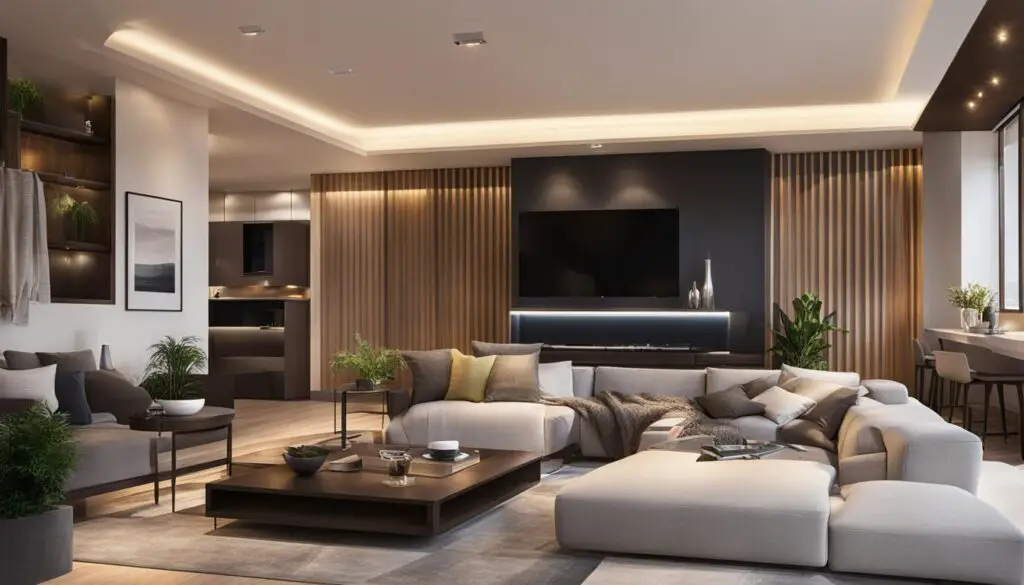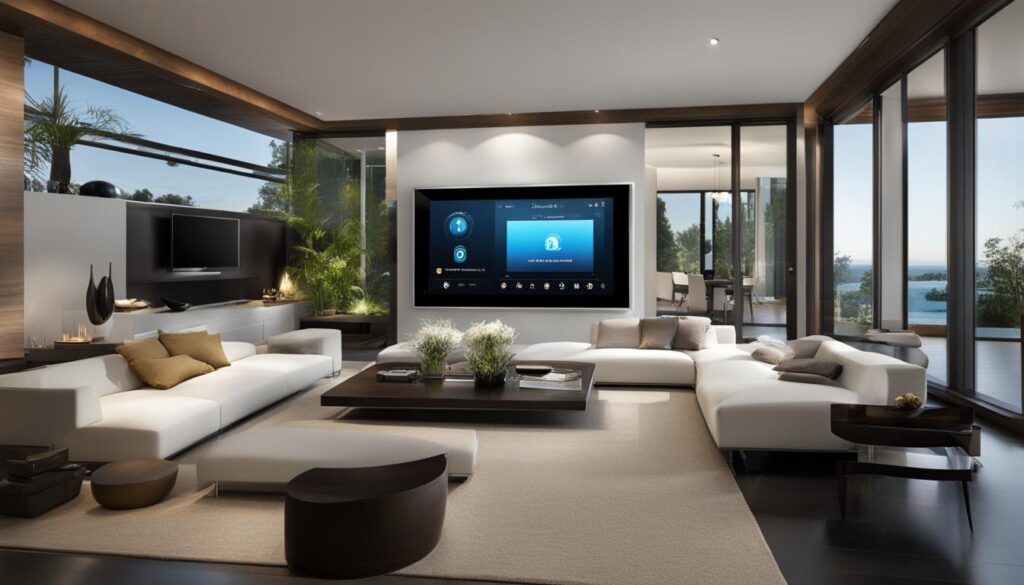Welcome to the ultimate guide to home automation! In this comprehensive guide, I will walk you through everything you need to know about home automation systems, smart home technology, home automation ideas, installation, benefits, and more. Home automation is revolutionizing the way we live, offering convenience, efficiency, and security like never before.
Home automation involves integrating technology into various aspects of your home to create a more efficient, convenient, and secure living space. From smart lighting and thermostat control to home security and surveillance, there are endless possibilities to enhance your daily life.
Building your own home automation system is achievable with careful planning and the right devices. Imagine being able to control your lights, temperature, appliances, and more from anywhere, at any time, using your smartphone or voice commands. With the right devices and automation setup, this can become a reality.
Investing in home automation offers numerous benefits. Not only does it provide convenience by allowing you to control your home remotely, but it also improves energy efficiency, enhances security, and creates a comfortable living environment. Additionally, a home automation system is future-proof, as it can easily adapt to evolving technology.
Table of Contents
Key Takeaways
- Home automation integrates technology into various aspects of your home for efficiency and convenience.
- Smart lighting, thermostat control, home security, and smart appliances are key components of a home automation system.
- Building your own home automation system involves careful planning, device selection, and integration through a central hub or smartphone app.
- Investing in home automation offers benefits such as convenience, energy efficiency, enhanced security, and future-proofing.
- By following the installation process and selecting the right devices, you can enjoy a hassle-free and efficient lifestyle.
Key Components of a Home Automation System
When it comes to creating a fully automated home, there are several key components that play a crucial role in transforming your living space into a smart and efficient environment. From smart lighting to thermostat control, home security and surveillance, and smart appliances, each component enhances the functionality and convenience of your home automation system.
Smart Lighting Systems
One of the fundamental aspects of a home automation system is smart lighting. With smart lighting systems, you have the ability to control the brightness, color, and timing of your lights remotely. Whether you want to create a cozy ambiance or adjust the lighting based on your preferences, smart lighting allows for seamless control and customization. Turn on the lights from your smartphone before arriving home or use voice commands to dim the lights while watching a movie.
Thermostat Control
Regulating the temperature of your home can make a significant impact on energy efficiency and comfort. With thermostat control, you can adjust the temperature remotely and set schedules based on your preferences. For example, you can lower the temperature while you’re at work and have it warm up before you arrive home, ensuring optimal comfort while reducing energy consumption.
Home Security and Surveillance Systems
Home security is a top priority for homeowners, and integrating it into your home automation system provides added convenience and peace of mind. Smart security cameras, motion detectors, and doorbell cameras enhance the safety of your home by providing real-time monitoring and alerts. You can remotely check the security footage, receive notifications on your smartphone, and even communicate with visitors at your door, all from the convenience of your fingertips.
Smart Appliances
Modern technology has transformed traditional household appliances into smart devices that can be controlled remotely. From the kitchen to the laundry room, smart appliances offer convenience and efficiency. Imagine being able to preheat your oven or start a load of laundry while you’re still at the office. With smart appliances, you have the power to save time and streamline your daily tasks, making your home life more manageable.

Investing in these key components of a home automation system brings automation and control to every corner of your home. Embrace the convenience, security, and efficiency that these technologies provide, and experience the true potential of a smart home.
Building Your Own Home Automation System
Building your own home automation system is an exciting journey towards transforming your home into a smart, connected haven. With a thoughtful approach, careful device selection, and seamless integration, you can create a customized home automation experience tailored to your needs. Here is a step-by-step guide to help you get started:
- Assess Your Needs: Begin by identifying your specific automation requirements. Consider the areas of your home that would benefit from automation, such as lighting, temperature control, security, and entertainment systems.
- Choose Compatible Devices: Research and select home automation devices that are compatible with each other and align with your needs. Look for devices that support popular protocols like Wi-Fi, Zigbee, or Z-Wave for seamless integration.
- Plan the Automation Flow: Map out how you want your devices to interact and automate tasks. For example, you can create scenarios where the lights turn on automatically when you enter a room or adjust the thermostat based on your schedule.
- Install and Configure Devices: Follow the manufacturer’s instructions to install and set up each device. Ensure proper placement, connectivity, and configuration for optimal performance.
- Integrate through a Central Hub or Smart Home Automation Platform: Connect all your devices through a central hub or a smart home automation platform. This central hub acts as the brain of your automation system, allowing you to control and manage all your devices from a single interface.
- Utilize a Smartphone App: Download the corresponding smartphone app provided by the manufacturer to control and monitor your home automation system remotely. The app offers convenience and accessibility, giving you full control of your devices from anywhere.
- Command with Voice: Take advantage of voice commands by integrating your home automation system with voice assistants like Amazon Alexa or Google Assistant. Control your devices simply by speaking, adding a new level of hands-free convenience.
By following these steps, you can build a comprehensive and efficient home automation system that elevates your lifestyle. Remember to regularly update your system and explore new automation possibilities to stay ahead in the smart home revolution.
The Benefits of a Smart Home
Investing in a home automation system offers numerous benefits. With the ability to control your home from anywhere, at any time, you can enjoy convenience and flexibility. Whether you’re at work, on vacation, or simply lounging in your living room, you can easily adjust your smart home devices to suit your needs and preferences.
One of the key advantages of home automation is energy efficiency. By optimizing your energy usage through automation, you can reduce your utility bills and minimize your environmental footprint. Smart thermostats can regulate your home’s temperature based on occupancy and weather conditions, ensuring efficient heating and cooling. Additionally, smart lighting systems allow you to schedule and control the brightness, color, and timing of your lights, saving energy and creating the perfect ambiance for each room.
Enhancing security is another significant benefit of smart home automation systems. With real-time alerts and monitoring capabilities, you can keep an eye on your home even when you’re away. Smart security cameras, motion detectors, and doorbell cameras provide peace of mind by deterring potential intruders and enabling you to assess any suspicious activity remotely. You can also integrate your security system with other devices, such as smart locks and sensors, to create a comprehensive home security solution.
In addition to convenience, energy efficiency, and security, a smart home offers enhanced comfort. Imagine arriving home to a perfectly lit living room, with your favorite music playing in the background, and the temperature set to your preferred level. With home automation, you can create personalized settings for various devices and scenarios, ensuring a comfortable living environment that matches your lifestyle. Whether you prefer a cozy and warm atmosphere or a bright and vibrant one, smart home technology can adapt to your preferences.
Last but not least, home automation ensures future-proofing of your home. As technology continues to advance, smart home systems can easily adapt and integrate with new devices and innovations. Investing in a smart home automation system now means you’ll be prepared for future advancements, ensuring that your home remains up-to-date and equipped with the latest technologies.
To summarize, a smart home offers a range of benefits, including convenience, energy efficiency, security, comfort, and future-proofing. By investing in a home automation system, you can transform your living space into a modern, efficient, and intelligent environment that enhances your daily life.
Conclusion
Home automation installation is the key to unlocking a world of convenience and efficiency in your daily life. By carefully choosing the right home automation system and devices, you can transform your house into a smart home that offers a range of benefits.
One of the primary advantages of home automation is the ability to control your home remotely. Whether you’re at work or on vacation, you can easily manage your lighting, thermostat, security cameras, and other devices with just a few taps on your smartphone or through voice commands.
But the benefits go beyond convenience. Home automation also promotes energy efficiency, allowing you to optimize your energy usage and reduce utility bills. With automated lighting and temperature control, you can ensure that energy is only consumed when and where it’s needed.
Moreover, home automation enhances your home security, offering peace of mind. With real-time alerts and remote monitoring, you can stay connected to your home even when you’re away. Additionally, investing in a home automation system can increase your home’s value, making it more attractive to potential buyers in the future.
FAQ
What is home automation?
Home automation is a revolutionary way of integrating technology into various aspects of your home to create a more efficient, convenient, and secure living space.
What are the key components of a home automation system?
The key components of a home automation system include smart lighting, thermostat control, home security and surveillance, and smart appliances.
How can I build my own home automation system?
Building your own home automation system involves assessing your needs, choosing compatible devices, planning the automation flow, installing and configuring the devices, and integrating them through a central hub or smart home automation platform.
How can I control my home automation system?
You can control your home automation system through a central hub or smartphone app. Voice commands can also be used for seamless control.
What are the benefits of home automation?
Investing in home automation offers numerous benefits, including convenience, energy efficiency, security, comfort, and future-proofing your home.
What should I consider when choosing a home automation system?
When choosing a home automation system, consider factors such as compatibility with your existing devices, ease of installation, user-friendly interface, and scalability for future expansion.


